HOME
GUARD MEMORIES AND
INFORMATION - WARWICKSHIRE, BIRMINGHAM
The
25th WARWICKSHIRE (BIRMINGHAM) BATT'N
and
Lt. ARTHUR
MUSSON
This
is a page within the www.staffshomeguard.co.uk
website. To
see full contents, go to SITE
MAP.
|
We are sad to learn that Mr. Arthur Musson passed away on Remembrance Sunday, 13th November 2010.
May this page help to keep his memory alive and act as a minor tribute to him and his dedicated service. |
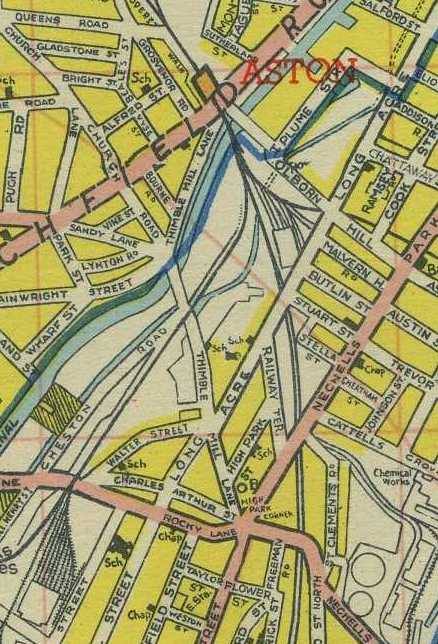
Parts of Aston were defended by
the 25th Warwickshire (Birmingham) Battalion, Home
Guard. The Commanding Officer of this Battalion
was Lt.Col. S.W.G. Walker,
MC, MM (late Lt., R.N.) and senior officers were Majors
C.J.E. Pitt and
F. Jackson (all
as at 1st February 1941). Its area of responsibility
was essentially the defence of many factories in the
area, perhaps the most significant of these being
the Hercules Cycle
works. In the early 1920s Hercules had expanded its Catherine Street factory into Rocky Lane, Aston and added another factory, Manor Mills in
nearby Long Acre, Nechells
in 1929. By the outbreak of war the Company
had produced some 6 million cycles, including most
of their components, and claimed to be the largest
manufacturer in the world.
(Please note : magnified versions of the images above and below can be seen by clicking on the image in question.)
Mr. Arthur
Musson was an employee of Hercules and
joined "D" Coy. of the 25th Warwickshire
Battalion whose responsibility included the works.
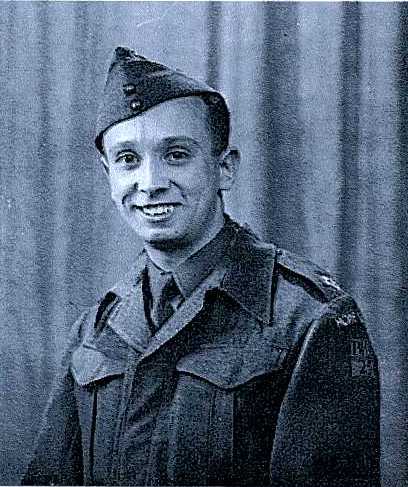 Arthur
Musson had grown up in Lea Village which he has
described as being at the time perhaps the loneliest,
most rural spot in Birmingham. On Saturday, 2nd
September 1939 he took his girl friend Mary to the
Capitol Cinema in Alum Rock; they entered in broad
daylight but when they emerged it was into complete
blackness. The black-out which would last for more
than five years was already being imposed. The
following day, a Sunday, Arthur was at his place of
work, M.E.M. Co. Ltd in Reddings Lane, Tyseley, taking his St. John's Ambulance examination in the canteen. A wireless had been installed and there he and his workmates listened to the Prime Minister, Neville Chamberlain, Arthur
Musson had grown up in Lea Village which he has
described as being at the time perhaps the loneliest,
most rural spot in Birmingham. On Saturday, 2nd
September 1939 he took his girl friend Mary to the
Capitol Cinema in Alum Rock; they entered in broad
daylight but when they emerged it was into complete
blackness. The black-out which would last for more
than five years was already being imposed. The
following day, a Sunday, Arthur was at his place of
work, M.E.M. Co. Ltd in Reddings Lane, Tyseley, taking his St. John's Ambulance examination in the canteen. A wireless had been installed and there he and his workmates listened to the Prime Minister, Neville Chamberlain,  telling the nation that from 11 o'clock that day we were at war with Germany. Despite this distraction the examination was successfully passed as the surviving certificate (right) confirms. It is hard to imagine a more appropriate date to qualify for "First Aid to the Injured" than Sunday, 3rd September 1939. telling the nation that from 11 o'clock that day we were at war with Germany. Despite this distraction the examination was successfully passed as the surviving certificate (right) confirms. It is hard to imagine a more appropriate date to qualify for "First Aid to the Injured" than Sunday, 3rd September 1939.
Not long afterwards, Arthur moved to the B.S.A. as a jig and tool draughtsman, initially in their Lanchester Factory in Montgomery Street, Small Heath where he worked on the 20mm quick-firing Oerlikon anti-aircraft gun. He was there at the time of Dunkirk and the Battle of Britain, working over 70 hours a week - all 7 days, from 8.00 a.m. to 7.30 p.m. except on Saturdays when he finished at 5.30. B.S.A. suffered grievously from aerial attack: following bomb damage he and his colleagues were transferred to a new office block at the end of Armoury Road. Further damage forced another move, this time to the motor-cycle Drawing Office which in turn was hit one night with one bomb falling a few feet from his drawing board. Fortunately the building was unoccupied at the time; but those in one of the multi-storey production blocks working the night shift were not so lucky and suffered great loss of life in one of the worst disasters of the Birmingham Blitz. After one of these many raids Arthur recalls walking down Golden Hillock Road where the Queens Gravy Salt factory had been burnt out, the 18-24" wide steel columns bent over like swans' necks due to the intense heat.
At the same time as the B.S.A. were running out of office space due to bomb damage as the Blitz continued, perhaps fortuitously the contract on which Arthur and some 30 other draughtsmen were working was completed and they were all released. It was at this time that he joined the Hercules Cycle Co. Ltd. in Rocky Lane, Aston, where he would stay for the next 8 years. Hercules was at that time still making a few bicycles for the forces but its main activity was munitions: 40mm shell bodies, 3.7" smoke emission shell bodies, impact fuses, mortar tail fins, land mine bodies and some aircraft parts.
Shortly after joining Hercules where somewhat more reasonable working hours were the norm, Arthur joined their works Home Guard unit on 4th May 1941. He has recorded a detailed description of that time and has generously permitted us to reproduce it here. This is his story.
Soon after moving to Hercules, I joined their Home Guard unit which was "D" Company, part of the 25th Warwickshire (Birmingham) Battalion, Home Guard. This was a factory-based unit in Aston.
Initially, I was in the first aid section, but an intelligence section was being formed and a number of us transferred. At Hercules, we were working five and half days a week, finishing at 1.00 p.m. on Saturdays. This was less than at the B.S.A, but well in excess of 50 hours, and with Home Guard duties, it came to a minimum of 65 hours. We only had 30 minutes break for lunch, so we used to wait for the exit gate to open and run up to the British Restaurant near Tower Road for our meal. The main course was about 1/- (one shilling = 5p) and the pudding 4d (4 old pence = 2p). After finishing our meal, we would run back to the factory and usually make it within the time spa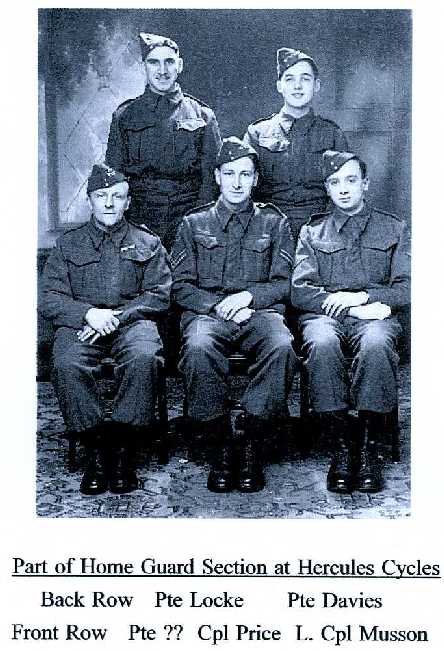 n. No wonder we are fitter than many of today's youth. n. No wonder we are fitter than many of today's youth.
We were on guard duty one night in eight, this meant doing a full day's work, followed by a night up with very little sleep,and then another day's work. On duty we took it in turns doing 4 hours on when we had to go round the factory checking that everything was in order and that there were no intruders or saboteurs about; fortunately we did not find any. We then had 4 hours off duty to get some sleep, if you were lucky. Each week we normally had one evening for lectures and a training exercise on Sunday mornings. I felt continually tired during this period. If an air raid took place when we were on duty, two of us would go up to a vantage point on the roof where there was a brick built look-out point from where there was a good view of the surrounding area. If the air raid was developing locally we would sound the sirens to get the workers to the shelters. When it was quieter again the siren would be sounded to get production going once more. Most factories had a similar policy using the Home Guard or Fire Watchers to evacuate workers when danger became imminent.
Sometimes we would go to the rifle range at Kingsbury where we got practical experience in rifle shooting and grenade throwing. There was also a .22 rifle range underground at the Hercules. Periodically we had major exercises at week ends. On one of these, members of the British and American Armies were trying to infiltrate Birmingham's security and act as saboteurs. During the war everyone had to carry identity cards including civilians, and these had to be produced when requested by anyone with authority. Check points were set up and at one we stopped a regular army officer and found the photograph on his pass was of Hitler, he had already been cleared a number of times. It still happens today.
On another occasion we were attacking Coventry. After being taking by bus to the outskirts of the town in the early morning, we de-bused in darkness and with all signposts having been removed due to the war we had not a clue as to our whereabouts. Our Battalion Intelligence Officer noticed a telephone kiosk nearby so he contacted the operator, gave the kiosk number and asked if she could give him the location which she did without hesitation. Security had broken down again.
The battalion wanted to recruit more commissioned officers. Our Battalion Commander Lt.-Col. Walker decided to organise an O.C.T.U. (Officer Cadet Training Unit) the first in the area. I applied and was accepted. After we were well advanced on the course, Zone, who controlled all of the Home Guard Battalions in the Birmingham area, decided it was a good idea and started their own training programme to which we had to transfer and start again.
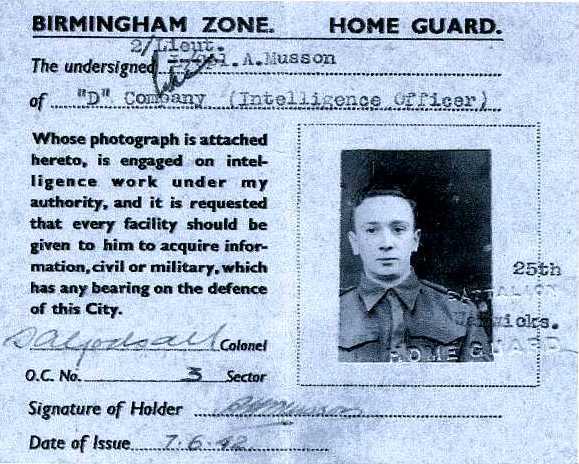 I eventually got my commission and was promoted to 2nd Lieutenant (promulgated in Battalion Orders on 9th March 1943) and later to Lieutenant. I was appointed 'D' Company Intelligence Officer and later Acting Battalion Intelligence Officer. Officers did one night duty about every three weeks staying at 'D' company headquarters on the Lichfield Road near Aston Railway Station. This was a very noisy place with the trams running most of the night. During the night when on duty we had to visit all of the factories in the Aston area who had Home Guard units in 'D' Company, call out their guards and inspect them. There were about 10 units in all. I eventually got my commission and was promoted to 2nd Lieutenant (promulgated in Battalion Orders on 9th March 1943) and later to Lieutenant. I was appointed 'D' Company Intelligence Officer and later Acting Battalion Intelligence Officer. Officers did one night duty about every three weeks staying at 'D' company headquarters on the Lichfield Road near Aston Railway Station. This was a very noisy place with the trams running most of the night. During the night when on duty we had to visit all of the factories in the Aston area who had Home Guard units in 'D' Company, call out their guards and inspect them. There were about 10 units in all.
During this period I gave lectures on Intelligence and Security, Sten guns and Map reading.
At a later date women were recruited into the Home Guard mainly to do clerical and non-combatant work, and I was involved in training them in subjects related to Intelligence and Security
We had a weekend training exercise at Ettington Park, Warwickshire under canvas. A dawn exercise had been planned, but as the weather was so dreadful we hoped it would be cancelled. I was duty officer on the Sunday and at about 5 a.m. the Company Commander, Major Kendrick, came round to tell me to get the men up. I went round all of the tents in pouring rain getting everyone up. I am sure I must have been the most unpopular officer on site that morning. Having got the troops up I was then informed that the exercise had been cancelled and that I had to go round again to tell them that they could go to the kitchens and get a cup of tea.
© Arthur Musson 2008
|

In the course of his service Arthur Musson qualified for and received several proficiency certificates recognising the training he received and the level of expertise which he achieved. Two of these have survived. (Click
on any of these thumbnail images to expand).
In parallel with the general improvement in professionalism as the Home Guard evolved and the initial panics and nervousness of 1940/41 subsided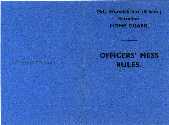 , units became increasingly sophisticated in the social aspects of their existence, organising sporting events, dances, concerts, children's Christmas parties and so on. Officers created Officers' Messes, properly established with published rules and procedures, and they also had their own social events. Details of this aspect of Home Guard life also survive in Arthur Musson's memorabilia. , units became increasingly sophisticated in the social aspects of their existence, organising sporting events, dances, concerts, children's Christmas parties and so on. Officers created Officers' Messes, properly established with published rules and procedures, and they also had their own social events. Details of this aspect of Home Guard life also survive in Arthur Musson's memorabilia.
At the end of his devoted service of more than three-and-a-half years and in common with all Home Guards who had served for a long period, Arthur received a gracious acknowledgement of his service from H.M. King George VI.
Magnified versions of the above images are available for viewing here. Or click on individual images.
ADDITIONAL INFORMATION
- There is more information
about the role of the 25th Warwickshire Battalion
on another
page of this website.
- The Battalion's role in
an air raid which badly damaged the firm of
L.H. Newton & Co. in Thimble Lane, Nechells
can be read here.
- The remarkable bravery
of two Home Guards belonging to an adjacent
Battalion during an air raid at Villa Cross
is described here.
- There's a link elsewhere
to a fascinating clip of online film which
shows members of "D" Coy. of the 23rd Warwickshire Battalion parading in Aston,
neighbours of Arthur Musson and his unit. To find it, click this
Memories-Warwickshire
link and look under 'Birmingham, Aston'.
- Read other stories of rooftop Home Guard vigils
- go to Memories-Warwickshire and look under 'Coventry' and 'Birmingham, Witton
- Kynoch Works' (Kynoch Works Air Raids).
|
ACKNOWLEDGEMENTS
We are most grateful to Mr. Musson for creating this memoir, allowing its publication in this website and providing additional information; and also to
the late June Eastlake of Birmingham for arranging its transmission to staffshomeguard.
|